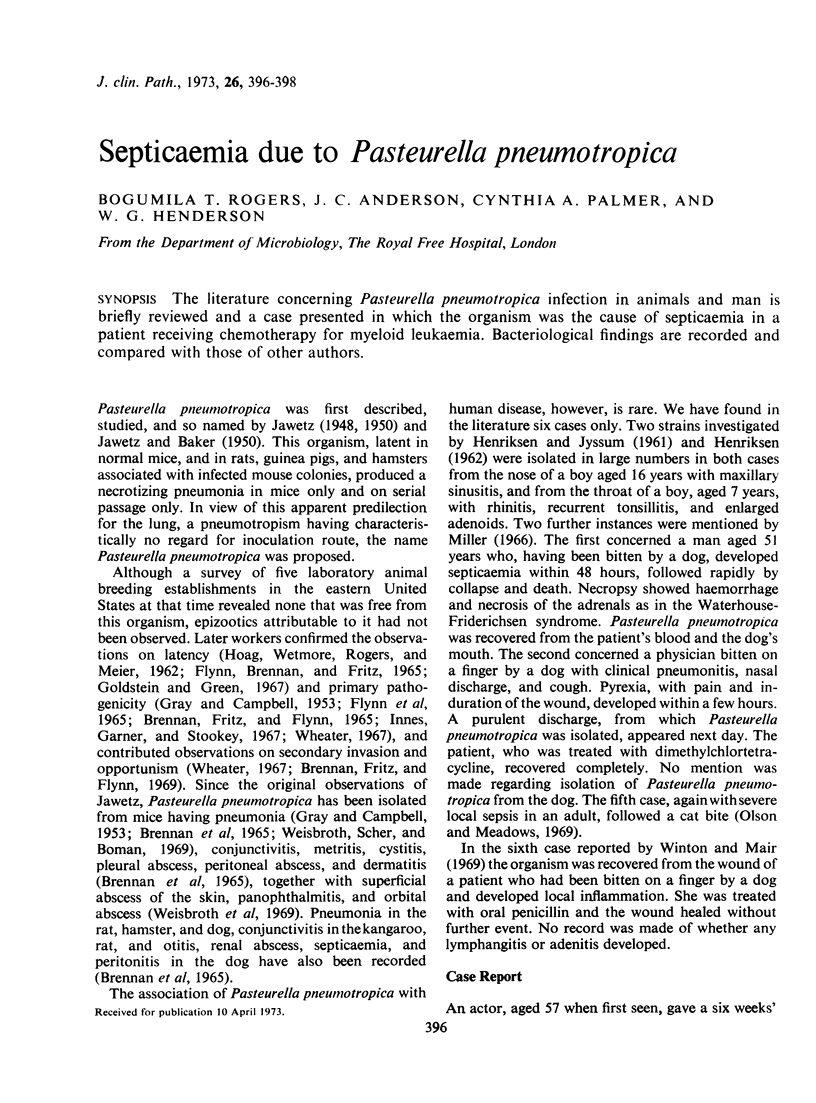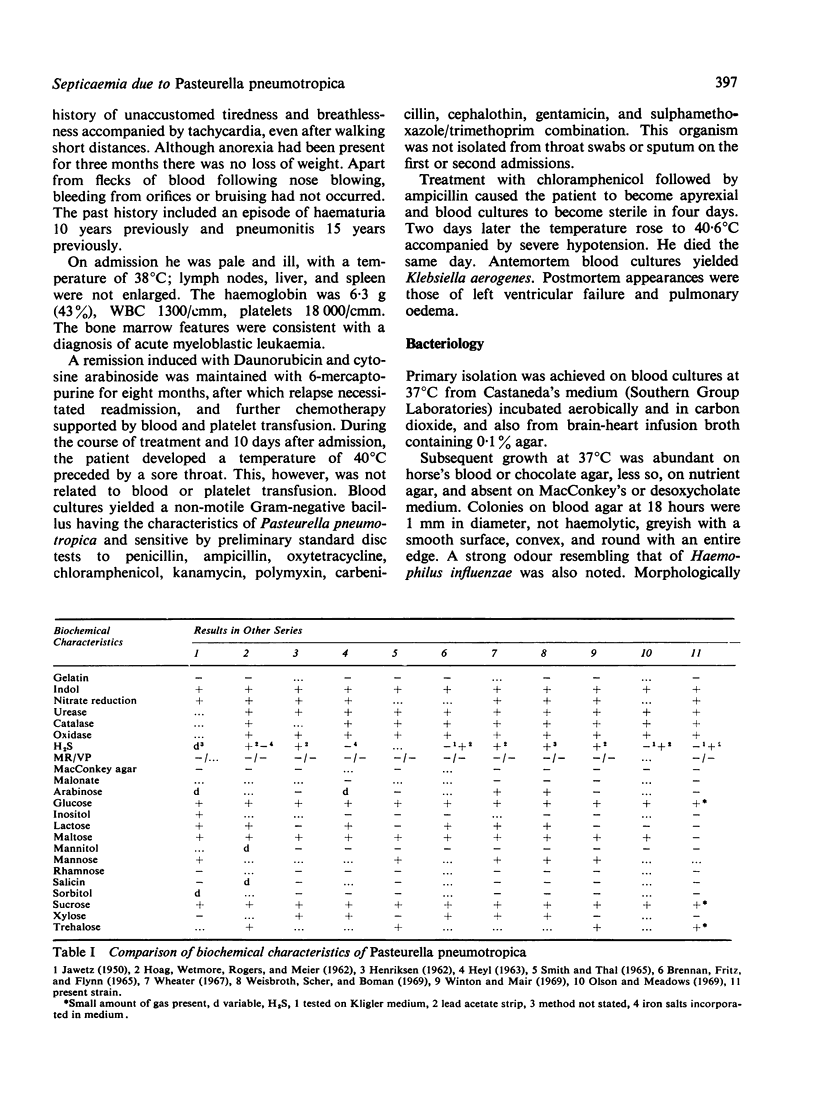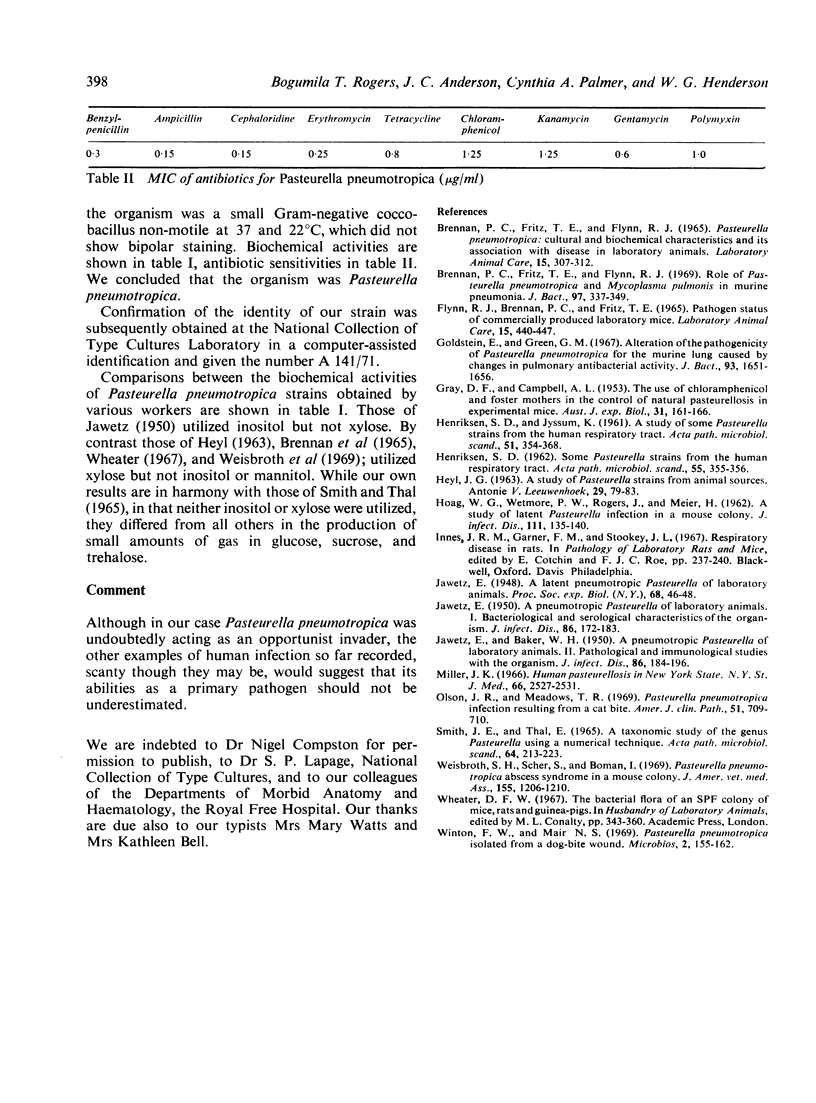Abstract
The literature concerning Pasteurella pneumotropica infection in animals and man is briefly reviewed and a case presented in which the organism was the cause of septicaemia in a patient receiving chemotherapy for myeloid leukaemia. Bacteriological findings are recorded and compared with those of other authors.
Full text
PDF


Selected References
These references are in PubMed. This may not be the complete list of references from this article.
- Brennan P. C., Fritz T. E., Flynn R. J. Pasteurella pneumotropica: cultural and biochemical characteristics, and its association with disease in laboratory animals. Lab Anim Care. 1965 Oct;15(5):307–312. [PubMed] [Google Scholar]
- Brennan P. C., Fritz T. E., Flynn R. J. Role of Pasteurella pneumotropica and Mycoplasma pulmonis in murine pneumonia. J Bacteriol. 1969 Jan;97(1):337–349. doi: 10.1128/jb.97.1.337-349.1969. [DOI] [PMC free article] [PubMed] [Google Scholar]
- GRAY D. F., CAMPBELL A. L. The use of chloramphenicol and foster mothers in the control of natural pasteurellosis in experimental mice. Aust J Exp Biol Med Sci. 1953 Apr;31(2):161–165. doi: 10.1038/icb.1953.19. [DOI] [PubMed] [Google Scholar]
- Goldstein E., Green G. M. Alteration of the pathogenicity of Pasteurella pneumotropica for the murine lung caused by changes in pulmonary antibacterial activity. J Bacteriol. 1967 May;93(5):1651–1656. doi: 10.1128/jb.93.5.1651-1656.1967. [DOI] [PMC free article] [PubMed] [Google Scholar]
- HENRIKSEN S. D., JYSSUM K. A study of some Pasteurella strains from the human respiratory tract. Acta Pathol Microbiol Scand. 1961;51:354–368. doi: 10.1111/j.1699-0463.1961.tb00374.x. [DOI] [PubMed] [Google Scholar]
- HENRIKSEN S. D. Some Pasteurella strains from the human respiratory tract. A correction and supplement. Acta Pathol Microbiol Scand. 1962;55:355–356. doi: 10.1111/j.1699-0463.1962.tb04136.x. [DOI] [PubMed] [Google Scholar]
- HEYL J. G. A study of Pasteurella strains from animal sources. Antonie Van Leeuwenhoek. 1963;29:79–83. doi: 10.1007/BF02046040. [DOI] [PubMed] [Google Scholar]
- HOAG W. G., WETMORE P. W., ROGERS J., MEIER H. A study of latent Pasteurella infection in a mouse colony. J Infect Dis. 1962 Sep-Oct;111:135–140. doi: 10.1093/infdis/111.2.135. [DOI] [PubMed] [Google Scholar]
- JAWETZ E. A pneumotropic pasteurella of laboratory animals; bacteriological and serological characteristics of the organism. J Infect Dis. 1950 Mar-Apr;86(2):172–183. doi: 10.1093/infdis/86.2.172. [DOI] [PubMed] [Google Scholar]
- JAWETZ E., BAKER W. H. A pneumotropic pasteurella of laboratory animals; pathological and immunological studies with the organism. J Infect Dis. 1950 Mar-Apr;86(2):184–196. doi: 10.1093/infdis/86.2.184. [DOI] [PubMed] [Google Scholar]
- Miller J. K. Human pasteurellosis in New York state. N Y State J Med. 1966 Oct 1;66(19):2527–2531. [PubMed] [Google Scholar]
- Olson J. R., Meadows T. R. Pasteurella pneumotropica infection resulting from a cat bite. Am J Clin Pathol. 1969 Jun;51(6):709–710. doi: 10.1093/ajcp/51.6.709. [DOI] [PubMed] [Google Scholar]
- Weisbroth S. H., Scher S., Boman I. Pasteurella pneumotropica abscess syndrome in a mouse colony. J Am Vet Med Assoc. 1969 Oct 1;155(7):1206–1210. [PubMed] [Google Scholar]


